warning Seat Leon SC 2013 SOUND SYSTEM 2.0
[x] Cancel search | Manufacturer: SEAT, Model Year: 2013, Model line: Leon SC, Model: Seat Leon SC 2013Pages: 48, PDF Size: 1.85 MB
Page 3 of 48
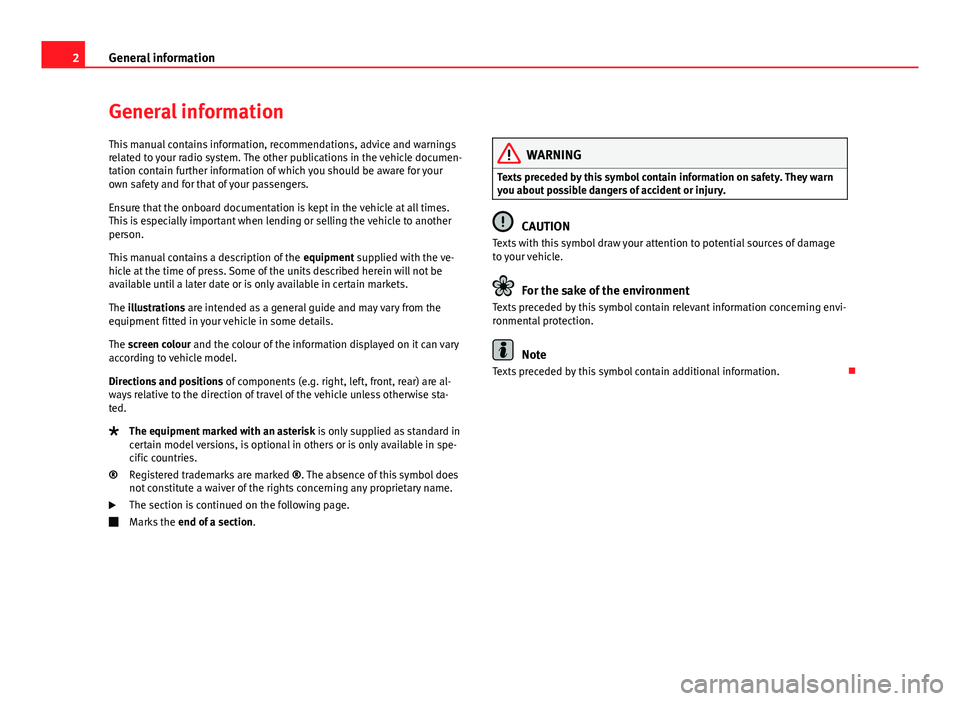
2General informationGeneral informationThis manual contains information, recommendations, advice and warningsrelated to your radio system. The other publications in the vehicle documen-tation contain further information of which you should be aware for yourown safety and for that of your passengers.
Ensure that the onboard documentation is kept in the vehicle at all times.This is especially important when lending or selling the vehicle to anotherperson.
This manual contains a description of the equipment supplied with the ve-hicle at the time of press. Some of the units described herein will not beavailable until a later date or is only available in certain markets.
The illustrations are intended as a general guide and may vary from theequipment fitted in your vehicle in some details.
The screen colour and the colour of the information displayed on it can varyaccording to vehicle model.
Directions and positions of components (e.g. right, left, front, rear) are al-ways relative to the direction of travel of the vehicle unless otherwise sta-ted.
The equipment marked with an asterisk is only supplied as standard incertain model versions, is optional in others or is only available in spe-cific countries.
Registered trademarks are marked ®. The absence of this symbol doesnot constitute a waiver of the rights concerning any proprietary name.
The section is continued on the following page.
Marks the end of a section.
®WARNINGTexts preceded by this symbol contain information on safety. They warnyou about possible dangers of accident or injury.
CAUTION
Texts with this symbol draw your attention to potential sources of damageto your vehicle.
For the sake of the environment
Texts preceded by this symbol contain relevant information concerning envi-ronmental protection.
Note
Texts preceded by this symbol contain additional information.
Page 4 of 48
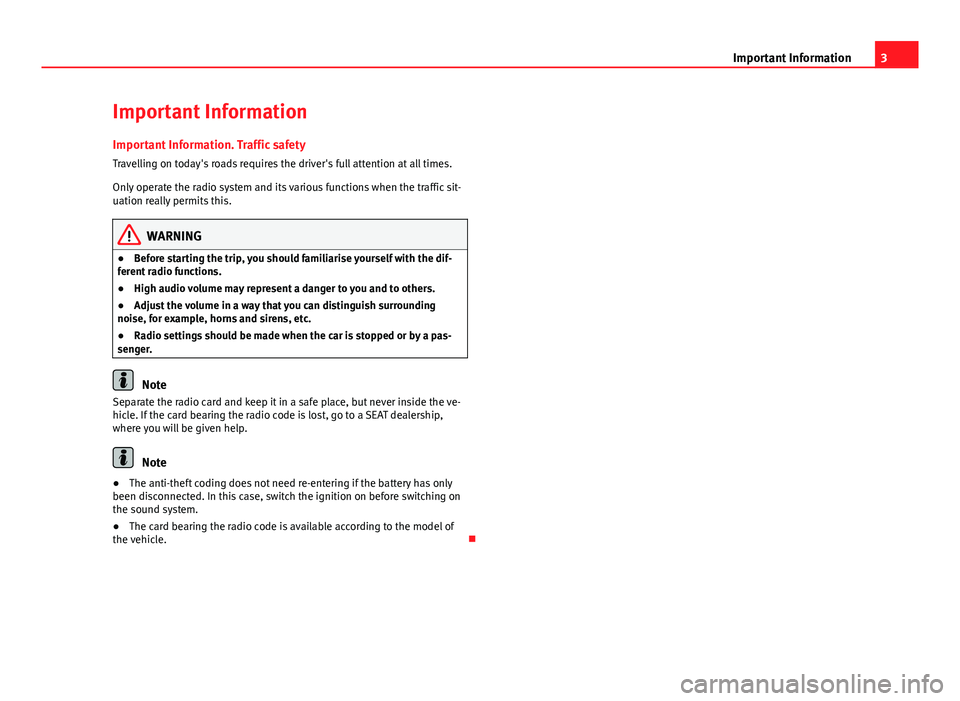
3Important InformationImportant InformationImportant Information. Traffic safety
Travelling on today's roads requires the driver's full attention at all times.
Only operate the radio system and its various functions when the traffic sit-uation really permits this.
WARNING●Before starting the trip, you should familiarise yourself with the dif-ferent radio functions.●
High audio volume may represent a danger to you and to others.
●
Adjust the volume in a way that you can distinguish surroundingnoise, for example, horns and sirens, etc.
●
Radio settings should be made when the car is stopped or by a pas-senger.
Note
Separate the radio card and keep it in a safe place, but never inside the ve-hicle. If the card bearing the radio code is lost, go to a SEAT dealership,where you will be given help.
Note
●The anti-theft coding does not need re-entering if the battery has onlybeen disconnected. In this case, switch the ignition on before switching onthe sound system.
●
The card bearing the radio code is available according to the model ofthe vehicle.
Page 5 of 48
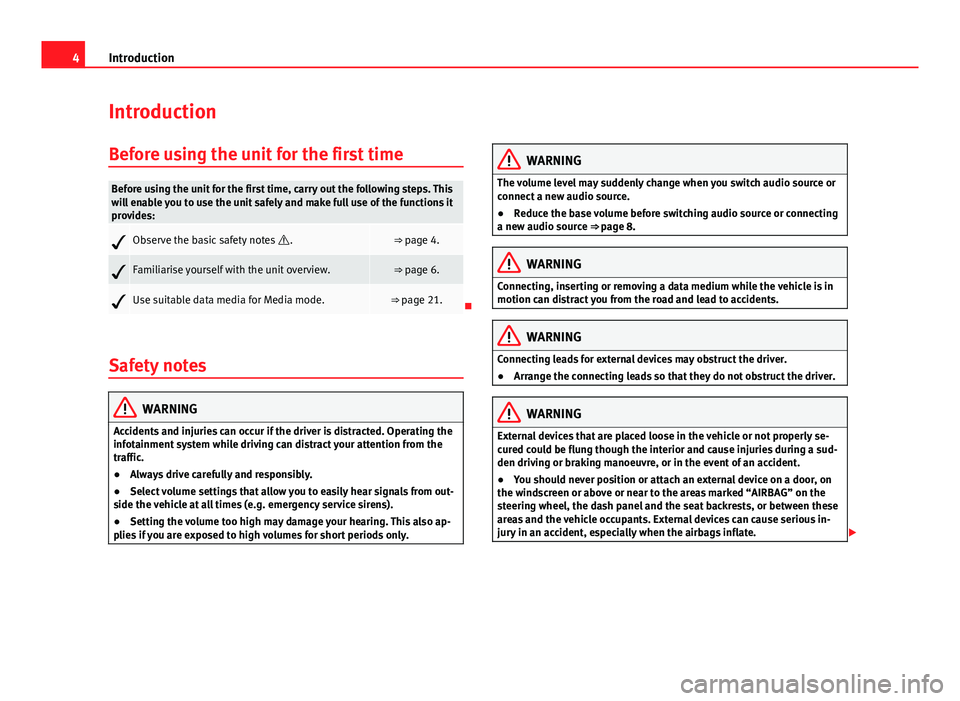
4IntroductionIntroductionBefore using the unit for the first timeBefore using the unit for the first time, carry out the following steps. Thiswill enable you to use the unit safely and make full use of the functions itprovides:Observe the basic safety notes .⇒ page 4.Familiarise yourself with the unit overview.⇒ page 6.Use suitable data media for Media mode.⇒ page 21.
Safety notes
WARNINGAccidents and injuries can occur if the driver is distracted. Operating theinfotainment system while driving can distract your attention from thetraffic.
●
Always drive carefully and responsibly.
●
Select volume settings that allow you to easily hear signals from out-side the vehicle at all times (e.g. emergency service sirens).
●
Setting the volume too high may damage your hearing. This also ap-plies if you are exposed to high volumes for short periods only.
WARNINGThe volume level may suddenly change when you switch audio source orconnect a new audio source.●
Reduce the base volume before switching audio source or connectinga new audio source ⇒ page 8.
WARNINGConnecting, inserting or removing a data medium while the vehicle is inmotion can distract you from the road and lead to accidents.WARNINGConnecting leads for external devices may obstruct the driver.●
Arrange the connecting leads so that they do not obstruct the driver.WARNINGExternal devices that are placed loose in the vehicle or not properly se-cured could be flung though the interior and cause injuries during a sud-den driving or braking manoeuvre, or in the event of an accident.
●
You should never position or attach an external device on a door, onthe windscreen or above or near to the areas marked “AIRBAG” on thesteering wheel, the dash panel and the seat backrests, or between theseareas and the vehicle occupants. External devices can cause serious in-jury in an accident, especially when the airbags inflate.
Page 6 of 48
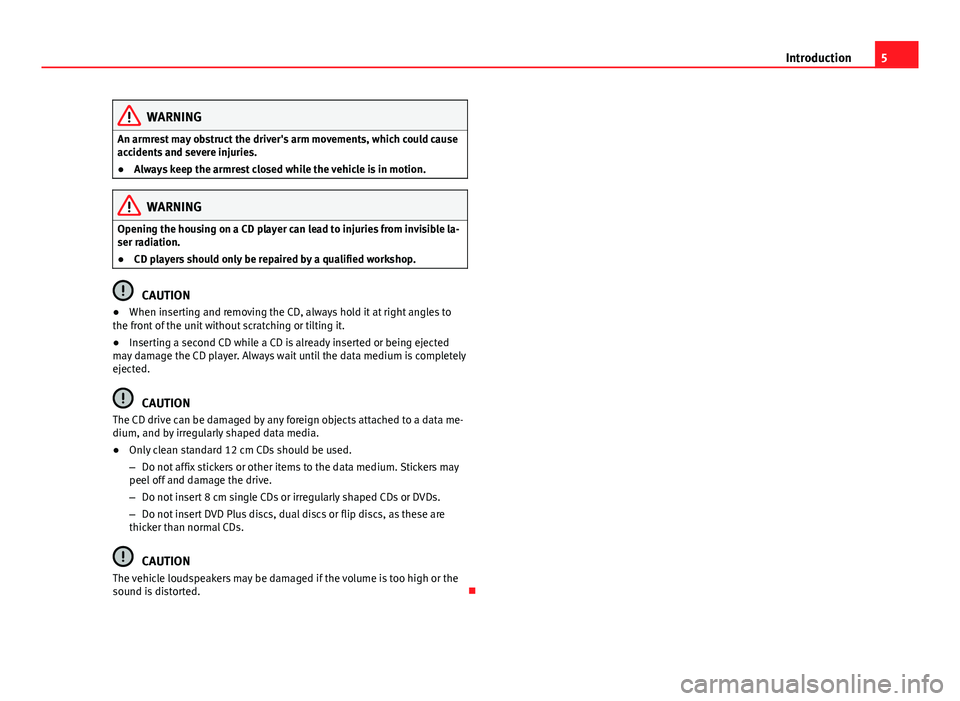
5IntroductionWARNINGAn armrest may obstruct the driver's arm movements, which could causeaccidents and severe injuries.●
Always keep the armrest closed while the vehicle is in motion.
WARNINGOpening the housing on a CD player can lead to injuries from invisible la-ser radiation.●
CD players should only be repaired by a qualified workshop.
CAUTION
●When inserting and removing the CD, always hold it at right angles tothe front of the unit without scratching or tilting it.●
Inserting a second CD while a CD is already inserted or being ejectedmay damage the CD player. Always wait until the data medium is completelyejected.
CAUTION
The CD drive can be damaged by any foreign objects attached to a data me-dium, and by irregularly shaped data media.●
Only clean standard 12 cm CDs should be used.
–
Do not affix stickers or other items to the data medium. Stickers maypeel off and damage the drive.
–
Do not insert 8 cm single CDs or irregularly shaped CDs or DVDs.
–
Do not insert DVD Plus discs, dual discs or flip discs, as these arethicker than normal CDs.
CAUTION
The vehicle loudspeakers may be damaged if the volume is too high or thesound is distorted.
Page 9 of 48
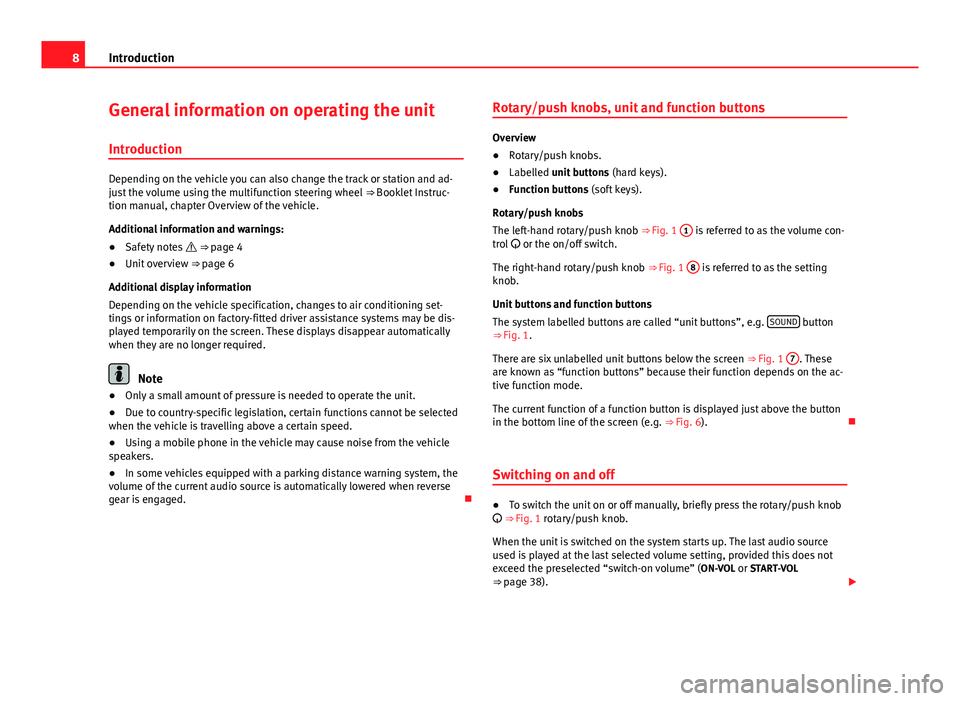
8IntroductionGeneral information on operating the unit
Introduction
Depending on the vehicle you can also change the track or station and ad-just the volume using the multifunction steering wheel ⇒ Booklet Instruc-tion manual, chapter Overview of the vehicle.
Additional information and warnings:
●
Safety notes ⇒ page 4
●
Unit overview ⇒ page 6
Additional display information
Depending on the vehicle specification, changes to air conditioning set-tings or information on factory-fitted driver assistance systems may be dis-played temporarily on the screen. These displays disappear automaticallywhen they are no longer required.
Note
●Only a small amount of pressure is needed to operate the unit.●
Due to country-specific legislation, certain functions cannot be selectedwhen the vehicle is travelling above a certain speed.
●
Using a mobile phone in the vehicle may cause noise from the vehiclespeakers.
●
In some vehicles equipped with a parking distance warning system, thevolume of the current audio source is automatically lowered when reversegear is engaged.
Rotary/push knobs, unit and function buttons
Overview
●
Rotary/push knobs.
●
Labelled unit buttons (hard keys).
●
Function buttons (soft keys).
Rotary/push knobs
The left-hand rotary/push knob ⇒ Fig. 1
1
is referred to as the volume con-trol or the on/off switch.
The right-hand rotary/push knob ⇒ Fig. 1
8
is referred to as the settingknob.
Unit buttons and function buttons
The system labelled buttons are called “unit buttons”, e.g. SOUND button⇒ Fig. 1.
There are six unlabelled unit buttons below the screen ⇒ Fig. 1
7
. Theseare known as “function buttons” because their function depends on the ac-tive function mode.
The current function of a function button is displayed just above the buttonin the bottom line of the screen (e.g. ⇒ Fig. 6).
Switching on and off
●
To switch the unit on or off manually, briefly press the rotary/push knob ⇒ Fig. 1 rotary/push knob.
When the unit is switched on the system starts up. The last audio sourceused is played at the last selected volume setting, provided this does notexceed the preselected “switch-on volume” (ON-VOL or START-VOL⇒ page 38).
Page 10 of 48
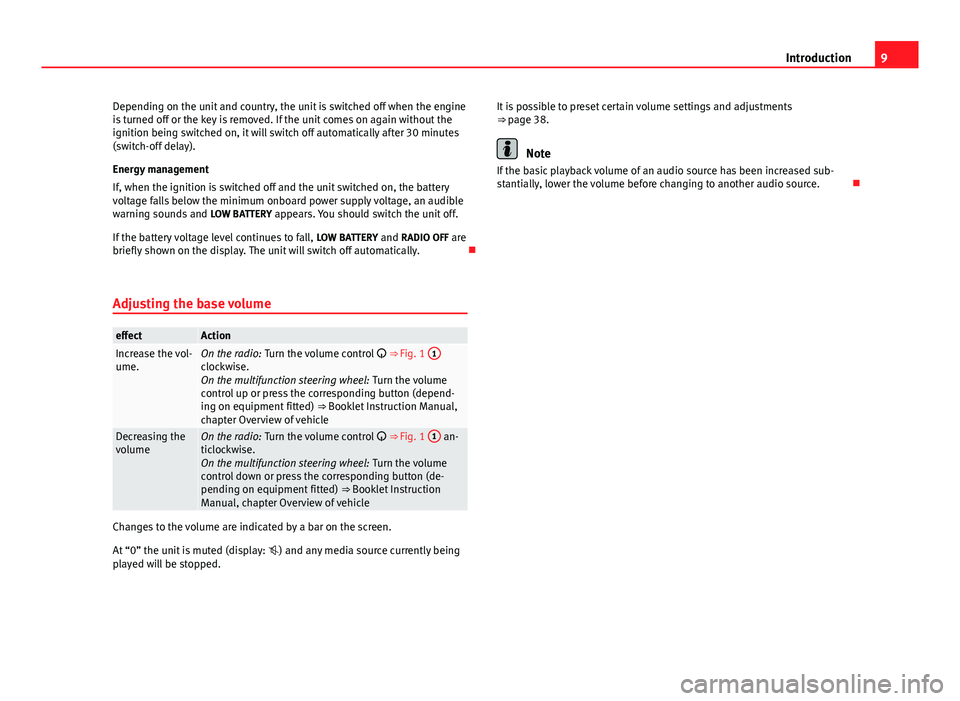
9IntroductionDepending on the unit and country, the unit is switched off when the engineis turned off or the key is removed. If the unit comes on again without theignition being switched on, it will switch off automatically after 30 minutes(switch-off delay).
Energy management
If, when the ignition is switched off and the unit switched on, the batteryvoltage falls below the minimum onboard power supply voltage, an audiblewarning sounds and LOW BATTERY appears. You should switch the unit off.
If the battery voltage level continues to fall, LOW BATTERY and RADIO OFF arebriefly shown on the display. The unit will switch off automatically.
Adjusting the base volume
effectActionIncrease the vol-ume.On the radio: Turn the volume control ⇒ Fig. 1 1
clockwise.On the multifunction steering wheel: Turn the volumecontrol up or press the corresponding button (depend-ing on equipment fitted) ⇒ Booklet Instruction Manual,chapter Overview of vehicle
Decreasing thevolumeOn the radio: Turn the volume control ⇒ Fig. 1 1 an-ticlockwise.On the multifunction steering wheel: Turn the volumecontrol down or press the corresponding button (de-pending on equipment fitted) ⇒ Booklet InstructionManual, chapter Overview of vehicle
Changes to the volume are indicated by a bar on the screen.
At “0” the unit is muted (display: ) and any media source currently beingplayed will be stopped.
It is possible to preset certain volume settings and adjustments⇒ page 38.
Note
If the basic playback volume of an audio source has been increased sub-stantially, lower the volume before changing to another audio source.
Page 11 of 48
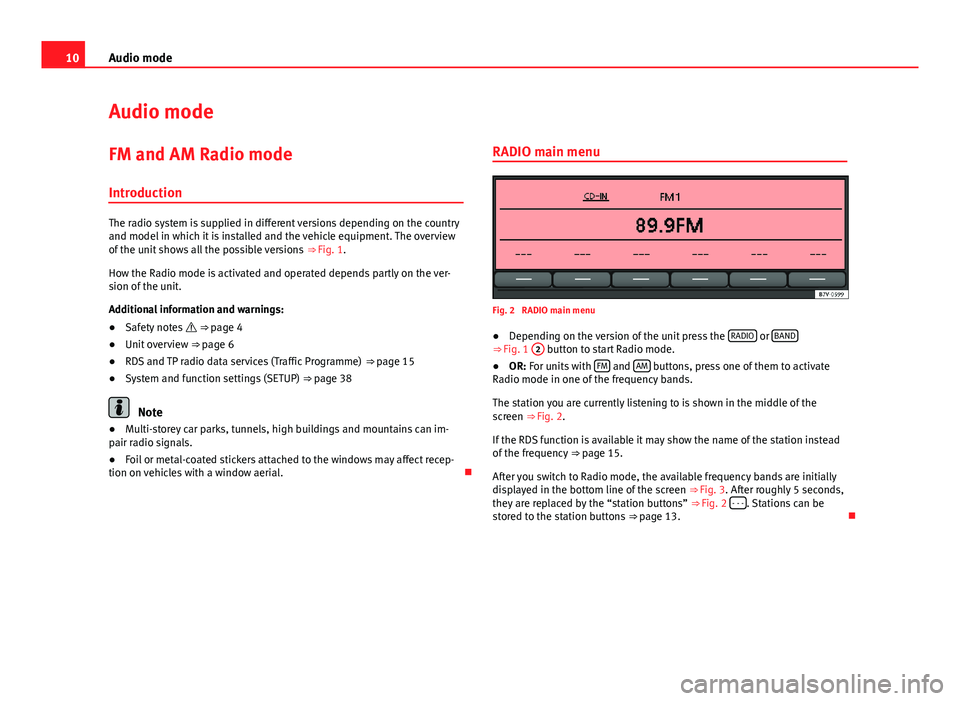
10Audio modeAudio modeFM and AM Radio mode
Introduction
The radio system is supplied in different versions depending on the countryand model in which it is installed and the vehicle equipment. The overviewof the unit shows all the possible versions ⇒ Fig. 1.
How the Radio mode is activated and operated depends partly on the ver-sion of the unit.
Additional information and warnings:
●
Safety notes ⇒ page 4
●
Unit overview ⇒ page 6
●
RDS and TP radio data services (Traffic Programme) ⇒ page 15
●
System and function settings (SETUP) ⇒ page 38
Note
●Multi-storey car parks, tunnels, high buildings and mountains can im-pair radio signals.●
Foil or metal-coated stickers attached to the windows may affect recep-tion on vehicles with a window aerial.
RADIO main menuFig. 2
RADIO main menu
●
Depending on the version of the unit press the RADIO or BAND⇒ Fig. 1
2
button to start Radio mode.
●
OR: For units with FM and AM buttons, press one of them to activateRadio mode in one of the frequency bands.
The station you are currently listening to is shown in the middle of thescreen ⇒ Fig. 2.
If the RDS function is available it may show the name of the station insteadof the frequency ⇒ page 15.
After you switch to Radio mode, the available frequency bands are initiallydisplayed in the bottom line of the screen ⇒ Fig. 3. After roughly 5 seconds,they are replaced by the “station buttons” ⇒ Fig. 2 - - -. Stations can bestored to the station buttons ⇒ page 13.
Page 16 of 48
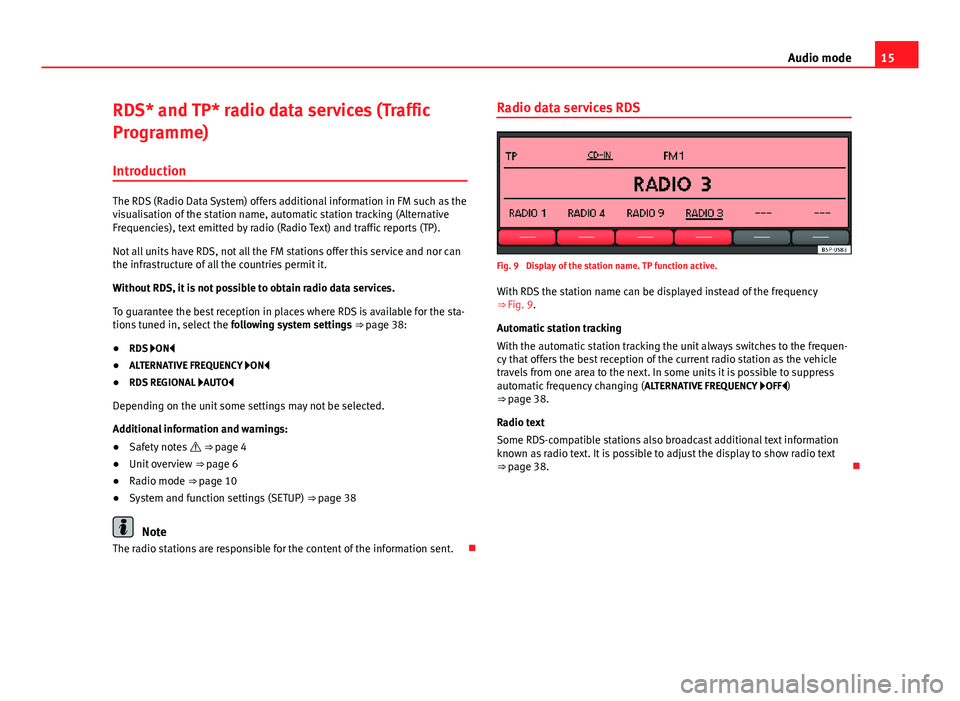
15Audio modeRDS* and TP* radio data services (Traffic
Programme)
Introduction
The RDS (Radio Data System) offers additional information in FM such as thevisualisation of the station name, automatic station tracking (AlternativeFrequencies), text emitted by radio (Radio Text) and traffic reports (TP).
Not all units have RDS, not all the FM stations offer this service and nor canthe infrastructure of all the countries permit it.
Without RDS, it is not possible to obtain radio data services.
To guarantee the best reception in places where RDS is available for the sta-tions tuned in, select the following system settings ⇒ page 38:
●
RDS ON
●
ALTERNATIVE FREQUENCY ON
●
RDS REGIONAL AUTO
Depending on the unit some settings may not be selected.
Additional information and warnings:
●
Safety notes ⇒ page 4
●
Unit overview ⇒ page 6
●
Radio mode ⇒ page 10
●
System and function settings (SETUP) ⇒ page 38
Note
The radio stations are responsible for the content of the information sent.
Radio data services RDSFig. 9
Display of the station name. TP function active.
With RDS the station name can be displayed instead of the frequency⇒ Fig. 9.
Automatic station tracking
With the automatic station tracking the unit always switches to the frequen-cy that offers the best reception of the current radio station as the vehicletravels from one area to the next. In some units it is possible to suppressautomatic frequency changing (ALTERNATIVE FREQUENCY OFF)⇒ page 38.
Radio text
Some RDS-compatible stations also broadcast additional text informationknown as radio text. It is possible to adjust the display to show radio text⇒ page 38.
Page 19 of 48
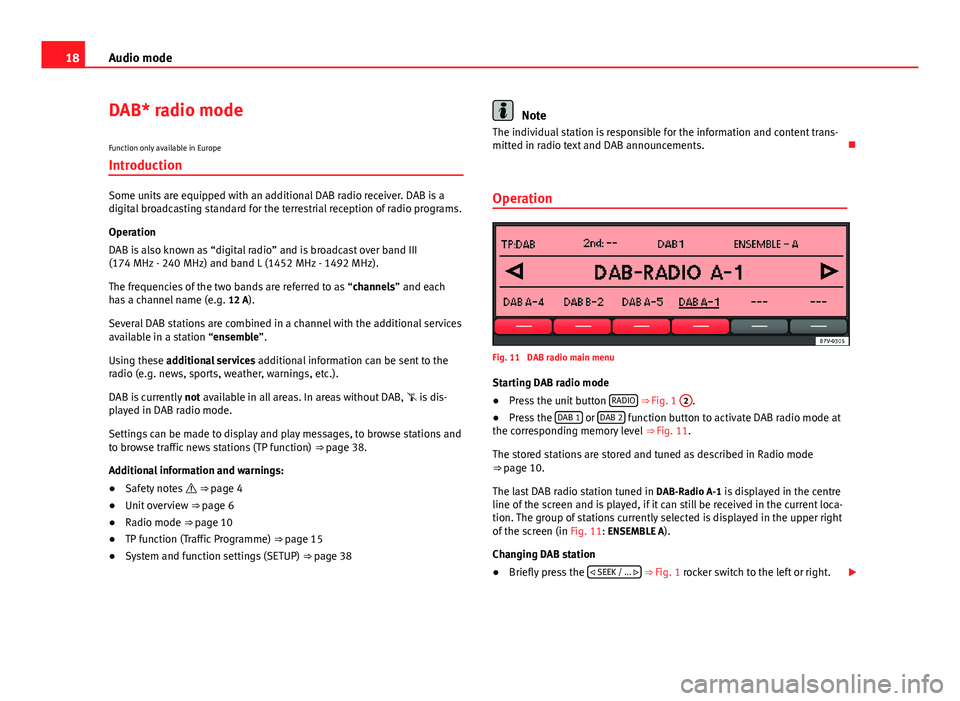
18Audio modeDAB* radio mode
Function only available in Europe
Introduction
Some units are equipped with an additional DAB radio receiver. DAB is adigital broadcasting standard for the terrestrial reception of radio programs.
Operation
DAB is also known as “digital radio” and is broadcast over band III(174 MHz - 240 MHz) and band L (1452 MHz - 1492 MHz).
The frequencies of the two bands are referred to as “channels” and eachhas a channel name (e.g. 12 A).
Several DAB stations are combined in a channel with the additional servicesavailable in a station “ensemble”.
Using these additional services additional information can be sent to theradio (e.g. news, sports, weather, warnings, etc.).
DAB is currently not available in all areas. In areas without DAB, is dis-played in DAB radio mode.
Settings can be made to display and play messages, to browse stations andto browse traffic news stations (TP function) ⇒ page 38.
Additional information and warnings:
●
Safety notes ⇒ page 4
●
Unit overview ⇒ page 6
●
Radio mode ⇒ page 10
●
TP function (Traffic Programme) ⇒ page 15
●
System and function settings (SETUP) ⇒ page 38
NoteThe individual station is responsible for the information and content trans-mitted in radio text and DAB announcements.
Operation
Fig. 11
DAB radio main menu
Starting DAB radio mode
●
Press the unit button RADIO ⇒ Fig. 1
2
.
●
Press the DAB 1 or DAB 2 function button to activate DAB radio mode atthe corresponding memory level ⇒ Fig. 11.
The stored stations are stored and tuned as described in Radio mode⇒ page 10.
The last DAB radio station tuned in DAB-Radio A-1 is displayed in the centreline of the screen and is played, if it can still be received in the current loca-tion. The group of stations currently selected is displayed in the upper rightof the screen (in Fig. 11: ENSEMBLE A).
Changing DAB station
●
Briefly press the SEEK / ... ⇒ Fig. 1 rocker switch to the left or right.
Page 22 of 48
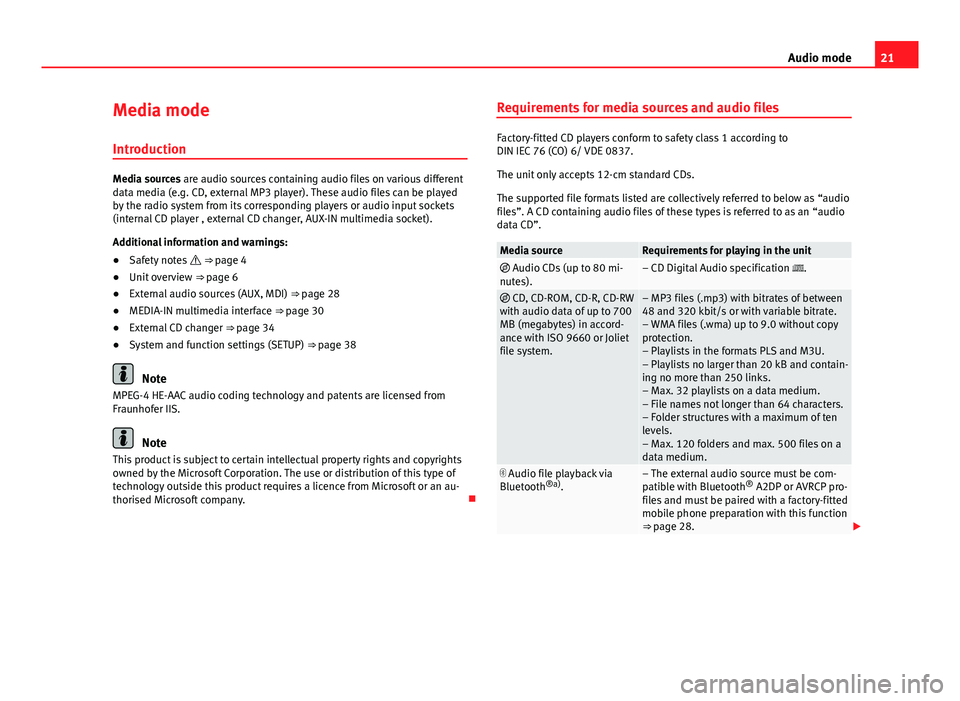
21Audio modeMedia mode
Introduction
Media sources are audio sources containing audio files on various differentdata media (e.g. CD, external MP3 player). These audio files can be playedby the radio system from its corresponding players or audio input sockets(internal CD player , external CD changer, AUX-IN multimedia socket).
Additional information and warnings:
●
Safety notes ⇒ page 4
●
Unit overview ⇒ page 6
●
External audio sources (AUX, MDI) ⇒ page 28
●
MEDIA-IN multimedia interface ⇒ page 30
●
External CD changer ⇒ page 34
●
System and function settings (SETUP) ⇒ page 38
Note
MPEG-4 HE-AAC audio coding technology and patents are licensed fromFraunhofer IIS.
Note
This product is subject to certain intellectual property rights and copyrightsowned by the Microsoft Corporation. The use or distribution of this type oftechnology outside this product requires a licence from Microsoft or an au-thorised Microsoft company.
Requirements for media sources and audio files
Factory-fitted CD players conform to safety class 1 according toDIN IEC 76 (CO) 6/ VDE 0837.
The unit only accepts 12-cm standard CDs.
The supported file formats listed are collectively referred to below as “audiofiles”. A CD containing audio files of these types is referred to as an “audiodata CD”.
Media sourceRequirements for playing in the unit Audio CDs (up to 80 mi-nutes).– CD Digital Audio specification . CD, CD-ROM, CD-R, CD-RWwith audio data of up to 700MB (megabytes) in accord-ance with ISO 9660 or Jolietfile system.
– MP3 files (.mp3) with bitrates of between48 and 320 kbit/s or with variable bitrate.– WMA files (.wma) up to 9.0 without copyprotection.– Playlists in the formats PLS and M3U.– Playlists no larger than 20 kB and contain-ing no more than 250 links.– Max. 32 playlists on a data medium.– File names not longer than 64 characters.– Folder structures with a maximum of tenlevels.– Max. 120 folders and max. 500 files on adata medium.
Audio file playback viaBluetooth®a).– The external audio source must be com-patible with Bluetooth® A2DP or AVRCP pro-files and must be paired with a factory-fittedmobile phone preparation with this function⇒ page 28.